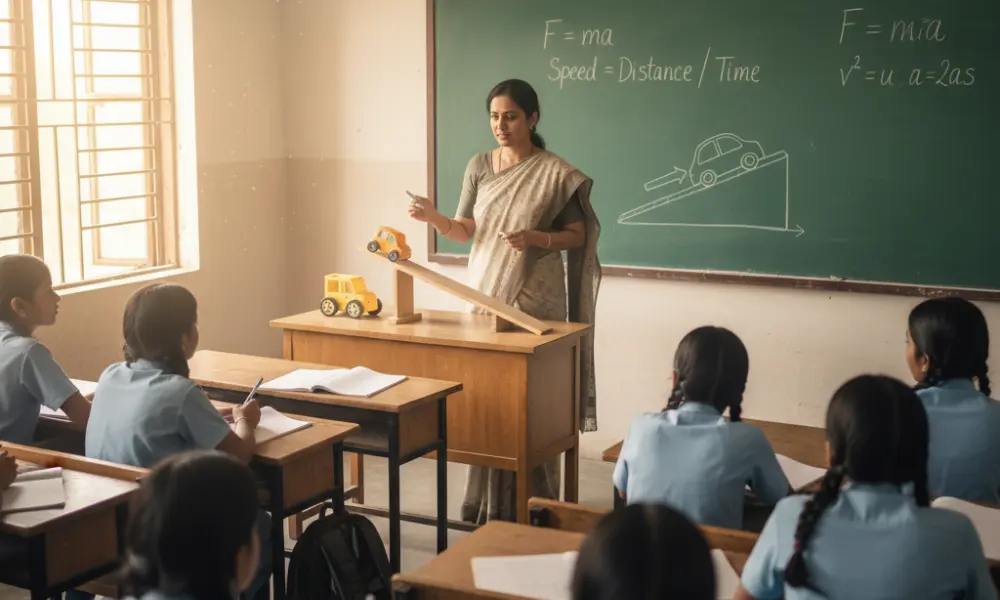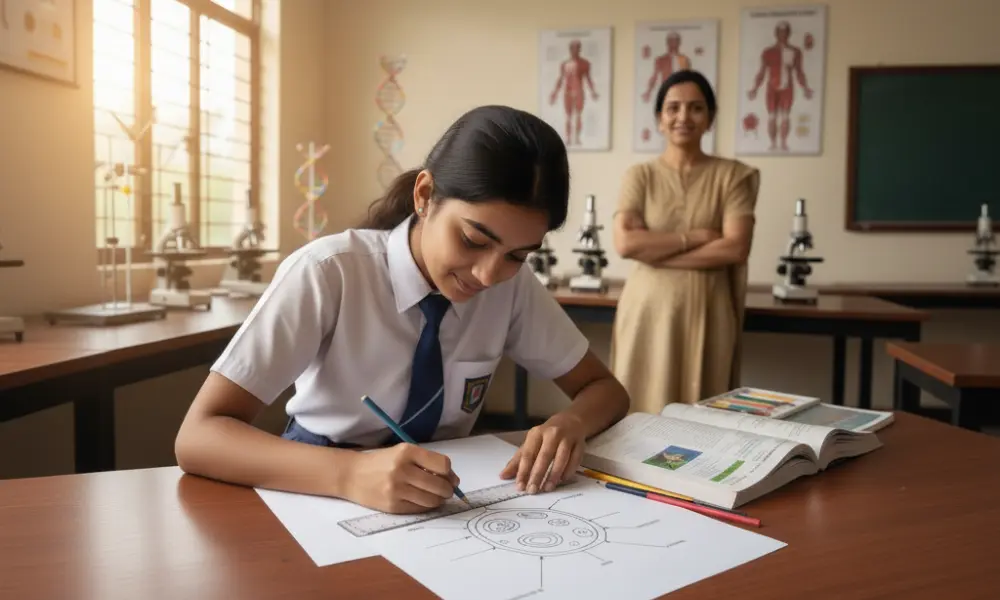Transform abstract NCERT science into engaging real-world learning experiences
Discover how to make CBSE science concepts come alive through everyday examples, kitchen experiments, and household observations. This comprehensive guide helps students, parents, and teachers turn abstract physics, chemistry, and biology concepts into relatable, hands-on learning experiences using common materials and familiar situations.

Picture this: your child stares blankly at their NCERT science textbook, overwhelmed by complex diagrams and abstract concepts that seem to have no connection to their daily life. Sound familiar? You're not alone. Thousands of CBSE students across India struggle with science not because they lack intelligence, but because traditional teaching methods often fail to bridge the gap between classroom theory and real-world applications.
Science isn't meant to be confined to textbooks and laboratories. It's everywhere around us – in the kitchen while cooking, in the garden while watering plants, and even in the simple act of riding a bicycle. The key to making NCERT science concepts stick is connecting them to experiences your child already knows and loves.
Before diving into solutions, let's understand the root of the problem. Most students find science challenging because of several interconnected factors that traditional teaching methods don't adequately address.
The primary issue lies in abstract presentation. When students encounter concepts like "electromagnetic induction" or "photosynthesis" without seeing their practical applications, these become mere words to memorize rather than phenomena to understand. The human brain naturally learns better when it can connect new information to existing knowledge and experiences.
Another significant barrier is the fear of making mistakes. Science education often emphasizes getting the "right" answer rather than encouraging exploration and questioning. This approach stifles the natural curiosity that drives scientific thinking. Students become passive recipients of information instead of active investigators.
Language complexity also plays a crucial role. NCERT textbooks, while comprehensive, sometimes use technical terminology that can intimidate young learners. When students can't relate to the language, they disconnect from the content entirely.
Finally, the lack of hands-on experiences makes science feel theoretical and irrelevant. Students memorize formulas and definitions without understanding their practical significance or seeing how they apply to everyday situations.
Physics surrounds us in countless ways, yet students often struggle to see these connections. Let's explore how common experiences can illuminate fundamental physics principles from the NCERT curriculum.
Every morning when your child rides their bicycle to school, they're experiencing Newton's laws of motion firsthand. The initial push to start moving demonstrates the law of inertia – objects at rest tend to stay at rest. The harder they pedal, the faster they accelerate, showing the direct relationship between force and acceleration from Newton's second law.
When they apply brakes, friction converts their kinetic energy into heat energy. You can actually feel this by touching the brake pads after a long ride. This simple observation covers multiple NCERT physics concepts: friction, energy conversion, and heat transfer.
Playing sports offers another treasure trove of physics lessons. A cricket ball's curved trajectory demonstrates projectile motion, while the spin bowlers put on the ball shows how air resistance and Magnus effect work together. Even jumping on a trampoline teaches concepts of potential and kinetic energy conversion.
The rainbow that appears when sunlight passes through water droplets during garden watering isn't just beautiful – it's a perfect demonstration of dispersion of light. This same principle explains why the sky appears blue and sunsets look red, connecting NCERT optics concepts to daily observations.
Sound concepts become clear through music and communication. When your child practices singing or playing an instrument, they're experimenting with frequency, amplitude, and resonance. The echo in an empty room teaches reflection of sound waves, while the muffled sounds through walls demonstrate absorption and transmission.
Every electrical appliance in your home is a physics lesson waiting to happen. The microwave oven demonstrates electromagnetic waves, while the refrigerator shows heat transfer and thermodynamics. Even static electricity generated by rubbing a balloon on hair can spark discussions about electric charges and fields.
Mobile phone charging introduces concepts of electrical current, potential difference, and power. The heating of phone chargers during use provides a tangible example of electrical energy conversion and Joule's heating effect.
The kitchen is perhaps the most underutilized chemistry laboratory in every home. From the moment you light the gas stove to when you clean dishes afterward, countless chemical reactions and principles come into play.
Baking a cake involves multiple chemical reactions that perfectly illustrate NCERT chemistry concepts. When baking soda (sodium bicarbonate) meets acidic ingredients like lemon juice or yogurt, it produces carbon dioxide gas, causing the cake to rise. This acid-base reaction is fundamental to understanding pH and chemical equations.
The browning of onions when cooked demonstrates the Maillard reaction, a complex series of chemical changes that create new flavors and colors. This process helps students understand how molecular structures change under heat and how new compounds form.
Even making tea involves multiple chemistry concepts. The extraction of flavor compounds from tea leaves shows dissolution and diffusion, while adding milk demonstrates emulsion formation. The change in color when lemon is added to tea illustrates acid-base indicators – the same principle used in chemistry labs.
Household cleaning provides excellent examples of chemical properties and reactions. Soap works through molecular polarity – its structure allows it to interact with both water and oil, explaining why it effectively removes grease stains. This concept directly relates to NCERT topics on molecular polarity and surface tension.
The fizzing action when baking soda meets vinegar creates an impressive demonstration of gas evolution reactions. Students can observe, measure, and even collect the carbon dioxide produced, making abstract chemical equations tangible and memorable.
Food preservation methods showcase various chemistry principles. Salt preservation (salting fish or making pickles) demonstrates osmosis and dehydration. The use of citric acid in preserving fruits shows how pH control prevents bacterial growth, connecting chemistry to microbiology concepts from the NCERT syllabus.
Biology isn't confined to dissection specimens and microscopic slides. It's the science of life itself, observable in every living thing around us, including our own bodies.
Students can explore their circulatory system by feeling their pulse at different activity levels. After running up stairs, they'll notice increased heart rate and breathing – perfect examples of how the circulatory and respiratory systems work together to meet increased oxygen demand. This observation makes NCERT concepts about heart rate, blood circulation, and gas exchange meaningful and personal.
Digestion becomes fascinating when students track what happens to their food. The feeling of hunger, the role of saliva when seeing favorite foods, and the satisfaction after eating all demonstrate different aspects of the digestive system. Even the rumbling stomach sounds can spark discussions about peristalsis and digestive processes.
Every garden or even a small potted plant offers rich biology lessons. Students can observe photosynthesis by noting how plants turn toward sunlight and grow better in bright conditions. The yellowing of leaves when plants don't get enough light directly demonstrates the importance of chlorophyll and light in plant nutrition.
Watering plants provides lessons about transpiration and water transport. Students can observe how cut flowers in a vase gradually wilt, showing water movement through plant tissues. Adding food coloring to the water makes this transport visible as the colored water moves up the stem.
The local park or even a backyard can become an ecosystem study site. Students can identify different organisms, observe feeding relationships, and understand concepts like food chains and biodiversity. Bird watching, insect observation, and plant identification all contribute to understanding ecological relationships described in NCERT biology.
Hands-on experiments transform theoretical knowledge into practical understanding. Here are engaging activities that require only common household items but deliver powerful learning experiences.
Create a volcano using baking soda, vinegar, and food coloring to demonstrate chemical reactions and gas evolution. This classic experiment never fails to excite students while teaching them about acid-base reactions, chemical equations, and energy changes.
Make natural pH indicators using red cabbage. Boil chopped red cabbage to extract natural anthocyanins, then use this purple liquid to test various household substances. Lemon juice turns it pink (acidic), while baking soda solution turns it green (basic). This experiment makes abstract pH concepts colorful and memorable.
Demonstrate crystallization by making salt or sugar crystals. Dissolve as much salt as possible in hot water, tie a string to a pencil, and suspend it in the solution. Over days, students can observe crystal formation, learning about saturation, solubility, and crystal structures.
Build a simple electromagnet using a nail, battery, and wire. Students can test its strength by counting how many paper clips it picks up, then experiment with different variables like wire coils or battery voltage. This hands-on activity makes electromagnetic concepts tangible and allows for genuine scientific investigation.
Create a periscope using mirrors and cardboard to demonstrate light reflection. Students can explore how light travels in straight lines and how mirrors change its path. This simple device connects to NCERT optics concepts while having practical applications.
Make a balloon-powered car using plastic bottles, balloons, and bottle caps as wheels. This experiment teaches Newton's third law (action-reaction), air pressure, and energy conversion in an engaging, hands-on way.
Sprout seeds in different conditions to understand germination requirements. Use identical seeds but vary light, water, and temperature conditions. Students can record daily observations, creating their own data about plant growth requirements and environmental factors.
Create a simple microscope using a smartphone camera and a small glass bead or water drop. Students can examine flower petals, leaf structures, or even onion skin cells, bringing microscopic biology concepts into their hands.
Visual learning transforms abstract concepts into concrete understanding. The human brain processes visual information much faster than text, making visual techniques particularly effective for science education.
Help students build mental models by using familiar analogies. Explain electrical current like water flowing through pipes – voltage is like water pressure, current is like flow rate, and resistance is like pipe diameter. This analogy makes abstract electrical concepts relatable and memorable.
For atomic structure, use the solar system model initially, then gradually introduce more accurate models. While not perfectly accurate, this familiar reference point helps students grasp the basic concept of electrons orbiting a nucleus before learning about quantum mechanical models.
Encourage students to create their own diagrams rather than just copying from textbooks. Drawing forces students to think through relationships and processes. A hand-drawn diagram of photosynthesis, even if imperfect, demonstrates understanding better than a memorized definition.
Use mind maps to connect related concepts. For example, a mind map about energy could branch into kinetic, potential, thermal, electrical, and chemical energy, with real-world examples for each type. This visual organization helps students see connections between different NCERT topics.
Leverage smartphone apps and online simulations to visualize abstract concepts. Apps that show molecular motion in different states of matter or simulations of planetary motion can make invisible phenomena visible and interactive.
Create time-lapse videos of plant growth, crystal formation, or chemical reactions. These visual records help students observe changes that occur too slowly for real-time observation, making processes like photosynthesis or crystallization more concrete.
Beyond teaching specific concepts, the goal is to develop scientific thinking – the ability to observe, question, hypothesize, and test ideas systematically.
Create a culture where questions are celebrated, not dismissed. When a child asks "Why is the sky blue?" don't just give the answer – explore it together. Look up information, conduct simple experiments, and discuss different aspects of the phenomenon. This approach teaches that science is about investigation, not just memorization.
Keep a family science journal where everyone records interesting observations or questions. Why do ice cubes crack when put in warm drinks? Why do some materials float while others sink? These everyday mysteries become starting points for scientific exploration.
Regular nature walks can develop keen observation skills. Challenge students to notice details – the different types of clouds, how plants respond to sunlight, or animal behaviors. These observations connect to NCERT concepts about weather, plant biology, and animal behavior.
Practice making predictions and testing them. Before dropping objects of different weights, ask students to predict which will hit the ground first. When their predictions prove wrong, discuss why – leading to conversations about air resistance, gravity, and experimental design.
Teach students to evaluate claims and evidence. When they hear advertisements about "scientifically proven" products, discuss what makes evidence reliable. This skill applies to NCERT concepts about scientific method and helps develop critical thinking beyond science class.
Encourage students to design their own experiments. If they wonder whether plants grow better with music, help them design a controlled experiment to test this idea. The process of experimental design teaches scientific thinking more effectively than memorizing others' experimental results.
While household materials provide excellent learning opportunities, additional resources can enhance and expand these experiences.
Platforms like Edzy gamify NCERT learning, making abstract concepts engaging through interactive activities and visual explanations. The AI-powered tutoring adapts to individual learning styles, providing personalized support for challenging concepts.
YouTube channels dedicated to science experiments and explanations offer visual demonstrations of concepts. Channels like "Veritasium" and "SciShow Kids" present science in engaging, accessible ways that complement NCERT textbook learning.
Local science museums, planetariums, and botanical gardens provide immersive learning experiences. Many offer educational programs specifically designed for school students, connecting classroom concepts to interactive exhibits and demonstrations.
Science clubs and maker spaces in communities provide opportunities for collaborative learning and access to equipment beyond what's available at home. These environments foster peer learning and expose students to diverse scientific interests.
A basic home science kit need not be expensive. Essential items include a magnifying glass, pH strips, measuring cups, thermometer, and basic chemicals like baking soda and vinegar. These simple tools enable numerous experiments that reinforce NCERT concepts.
Create dedicated spaces for observation and experimentation. Even a corner of a room with good lighting and storage for materials can become a learning hub. Having a consistent space for science activities signals their importance and makes regular exploration more likely.
The transformation of science education from abstract memorization to engaging exploration requires intentional effort from parents, teachers, and students. By connecting NCERT concepts to everyday experiences, conducting simple experiments, and fostering scientific curiosity, we can help students develop both understanding and enthusiasm for science.
Remember that every child learns differently. Some may be visual learners who benefit from diagrams and demonstrations, while others learn better through hands-on experimentation or verbal explanations. The key is providing multiple pathways to understanding, using the rich laboratory of everyday life to make science concepts accessible, memorable, and meaningful.
When students see science as relevant to their daily lives rather than confined to textbooks and exams, they develop the scientific temperament that will serve them throughout their lives. This approach not only improves academic performance but also prepares them to be informed citizens who can think critically about scientific issues and innovations that shape our world.

Unlocking the Power of Grammar: Common English Mistakes CBSE Students Should Avoid
Master grammar to enhance your writing and avoid common pitfalls.

Everyday Chemistry: Real-Life Examples That Make Concepts Stick
Discover how everyday chemistry makes learning engaging and relatable.

Physics Numericals Simplified: Step-by-Step Approach for Class 9 and 10
Master Physics numericals with a step-by-step approach for Class 9 and 10.

Mastering NCERT Diagrams: Tips to Score Full Marks in Biology
Unlock the secrets to scoring full marks in Biology with effective diagram techniques.